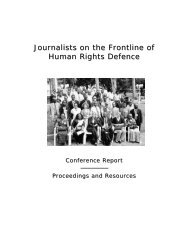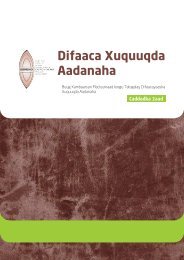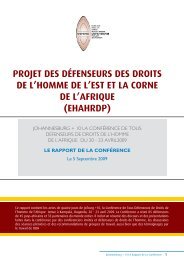Table of Contents - East and Horn of Africa Human Rights ...
Table of Contents - East and Horn of Africa Human Rights ...
Table of Contents - East and Horn of Africa Human Rights ...
Create successful ePaper yourself
Turn your PDF publications into a flip-book with our unique Google optimized e-Paper software.
Regional Workshop on Women <strong>and</strong> Minority <strong>Human</strong> <strong>Rights</strong> Defenders<br />
Nonetheless, it’s sometimes difficult not to become discouraged <strong>and</strong> disillusioned when faced by these<br />
subtle but very effective weapons. It’s sometimes difficult to go against widely held beliefs, values,<br />
traditions <strong>and</strong> norms. By struggling for the rights <strong>of</strong> the vulnerable, the stigmatised, the ostracised, you<br />
sometimes put yourselves at various forms <strong>of</strong> risk.<br />
Let my end then, by commending you all for the courage that you display by performing the work that<br />
you do. Hopefully through your participation at this conference, you have been further encouraged to<br />
continue <strong>and</strong> extend your immensely valuable effort, <strong>and</strong> you have been able to develop <strong>and</strong> strengthen<br />
networks that will be a source <strong>of</strong> support in your future work. Please rest assured <strong>of</strong> our support <strong>and</strong> our<br />
common commitment to the advancement <strong>of</strong> human rights for all.<br />
III Mainstreaming Gender into <strong>Human</strong> <strong>Rights</strong> Defenders Work, Jacqueline Asiimwe<br />
� Assumption: <strong>Human</strong> rights <strong>and</strong> fundamental freedom, being inherent in the human person,<br />
belong to women <strong>and</strong> men alike.<br />
� Mainstream human rights approaches have therefore long insisted that human rights norms are<br />
gender-neutral, or unaffected by gender.<br />
� However, structural imbalances <strong>of</strong> power between women <strong>and</strong> men, the systemic nature <strong>of</strong><br />
discrimination against women <strong>and</strong> the general absence <strong>of</strong> women in law creation <strong>and</strong><br />
implementation continue to reflect disproportionately the experiences <strong>of</strong> men <strong>and</strong> exclude the<br />
experiences <strong>of</strong> women.<br />
� The exclusion <strong>of</strong> women’s experiences perpetuate inattention to gender specific abuses<br />
predominantly suffered by women.<br />
� Issues that are not part <strong>of</strong> the traditional human rights canon but are being raised by women as<br />
human rights concerns include the many forms <strong>of</strong> violence in private <strong>and</strong> public, access to<br />
reproductive health services, discriminatory laws, etc<br />
� When the paramount purpose <strong>of</strong> human rights <strong>and</strong> fundamental freedoms is their enjoyment by<br />
all, without discrimination, then these rights must be conceptualized in such a way that women’s<br />
<strong>and</strong> men’s enjoyment finds its space in that interpretation <strong>and</strong> realization.<br />
� In recent years, ‘gender mainstreaming’ has become a key strategy for development practitioners<br />
to promote gender equality.<br />
� This concept came into widespread use following the 1995 UN International Conference on<br />
Women <strong>and</strong> adoption <strong>of</strong> the ‘Beijing Platform for Action’ for women’s advancement.<br />
� It draws on lessons learnt from past efforts to try <strong>and</strong> redress a gender-blind approach to<br />
development that has tended to ignore <strong>and</strong> marginalise women.<br />
� From an initial focus on targeting women to meet their immediate needs, strategies to ensure that<br />
women benefit from development have evolved to focus increasingly on addressing unequal<br />
power relations between women <strong>and</strong> men (gender relations).<br />
� A commitment to ensure that women’s as well as men’s concerns <strong>and</strong> experiences are integral to<br />
the design, implementation, monitoring <strong>and</strong> evaluation <strong>of</strong> all legislation, policies <strong>and</strong><br />
programmes so that women as well as men benefit equally <strong>and</strong> inequality is not perpetuated.<br />
� An approach <strong>of</strong> ensuring that organizational policies <strong>and</strong> plans recognize <strong>and</strong> respond to the<br />
different positionalities <strong>of</strong> (wo)men at all levels <strong>and</strong> in all domains.<br />
� Gender mainstreaming comprises two elements: (i) data collection <strong>and</strong> analysis <strong>of</strong> gender<br />
differences <strong>and</strong> relationships, <strong>and</strong> (ii) the incorporation <strong>of</strong> this underst<strong>and</strong>ing into our work,<br />
principally by the deployment <strong>of</strong> strong skills in advocacy <strong>and</strong> in participatory <strong>and</strong> consultative<br />
policy <strong>and</strong> planning methodologies.<br />
� Gender Mainstreaming is integral to all development decisions; it concerns the staffing,<br />
procedures <strong>and</strong> culture <strong>of</strong> development organisations as well as their programmes; <strong>and</strong> it is the<br />
responsibility <strong>of</strong> all everybody<br />
� It is a strategy for pivoting Gender Equality in development.<br />
� It is about <strong>Contents</strong> <strong>and</strong> Impacts <strong>of</strong> development.<br />
35 | P a g e








